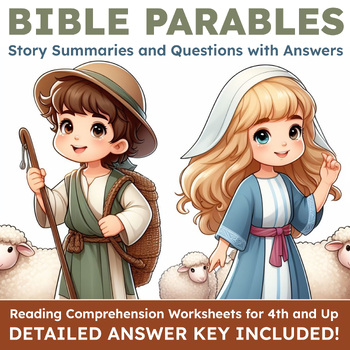Bible Parables: 30 Story Summaries w/ Questions and Answer Key (Kids and Adults)
- PDF
Description
This is a set of educational resources focused on the Parables of Jesus from the Bible. Each worksheet serves as a detailed study guide for a specific parable, offering a summary of the story, highlighting its key themes and spiritual lessons. It also challenges the reader to explore the topic further by asking critical thinking questions and inspiring thought and discussion.
These biblical stories, laden with metaphorical richness, transcend the boundaries of time and culture, inviting contemplation and reflection. Each parable conveys profound insights about God's kingdom, human nature, and the transformative power of faith. These stories explore themes of repentance, forgiveness, compassion, stewardship, and the profound nature of God's love.
Each parable serves as a guidepost on the path of spiritual growth, offering insights that resonate across generations and cultures, continuing to inspire and challenge believers on their journey of faith.
This is an assortment of 30 Reading Comprehension worksheets. They can be enjoyed by any grade level - and it's even great for adults! Much of this is written for at least a 4th grade reading level, but can be adjusted for a younger audience. It contains passages of assorted lengths and difficulties with multiple choice questions, open-ended questions, and critical thinking questions.
This is perfect for general education class, sunday school, home school session, or church programs.
It also includes a detailed answer key with example responses.
The topics included are:
- The Parable of the Sower (Matthew 13:1-23, Mark 4:1-20, Luke 8:4-15)
- The Parable of the Wheat and the Tares (Matthew 13:24-30, 36-43)
- The Parable of the Mustard Seed (Matthew 13:31-32, Mark 4:30-32, Luke 13:18-19)
- The Parable of the Leaven (Matthew 13:33, Luke 13:20-21)
- The Parable of the Hidden Treasure (Matthew 13:44)
- The Parable of the Pearl of Great Price (Matthew 13:45-46)
- The Parable of the Dragnet (Matthew 13:47-50)
- The Parable of the Unforgiving Servant (Matthew 18:21-35)
- The Parable of the Laborers in the Vineyard (Matthew 20:1-16)
- The Parable of the Two Sons (Matthew 21:28-32)
- The Parable of the Wicked Vinedressers (Matthew 21:33-46, Mark 12:1-12, Luke 20:9-19)
- The Parable of the Wedding Feast (Matthew 22:1-14)
- The Parable of the Fig Tree (Matthew 24:32-35, Mark 13:28-31, Luke 21:29-33)
- The Parable of the Ten Virgins (Matthew 25:1-13)
- The Parable of the Talents (Matthew 25:14-30)
- The Parable of the Sheep and the Goats (Matthew 25:31-46)
- The Parable of the Barren Fig Tree (Luke 13:6-9)
- The Parable of the Lost Sheep (Matthew 18:12-14, Luke 15:3-7)
- The Parable of the Lost Coin (Luke 15:8-10)
- The Parable of the Prodigal Son (Luke 15:11-32)
- The Parable of the Good Samaritan (Luke 10:25-37)
- The Parable of the Friend at Midnight (Luke 11:5-8)
- The Parable of the Rich Fool (Luke 12:16-21)
- The Parable of the Unjust Steward (Luke 16:1-13)
- The Parable of the Rich Man and Lazarus (Luke 16:19-31)
- The Parable of the Persistent Widow (Luke 18:1-8)
- The Parable of the Pharisee and the Tax Collector (Luke 18:9-14)
- The Parable of the Ten Minas (Luke 19:11-27)
- The Parable of the Good Shepherd (John 10:1-18)
- The Parable of the Vine and Branches (John 15:1-17)
These reading passages can benefit students of all grades and skill levels and teachers.
Developing Reading Skills
Improving Language Proficiency
Encouraging Critical Thinking
Building Knowledge Base
Catering to Different Learning Styles
Preparation for Standardized Tests
Fostering Classroom Discussions
You can use these worksheets in any way you see fit:
- Print them and distribute them in class
- Use them in small group settings
- Use them as a whole class discussion
- Copy and paste the passages and questions for presentations
- And various other teaching strategies.
You just can't redistribute this work as your own.
By integrating this worksheet creatively, teachers can cater to diverse learning styles, promote critical thinking, encourage research skills, and foster a deeper understanding of the topic among their students.
The worksheets include:
Text (about one page in length) of relevant information. The worksheet includes a carefully crafted passage that is accessible and captivating for students. The inclusion of relevant details, anecdotes, and key events about the topic help make the reading informative and engaging.
Questions based on the reading. They are an effective tool for reinforcing students' understanding. These questions cover a range of cognitive levels, encouraging students to recall facts, analyze information, and make connections between different aspects of the reading.
Critical thinking questions to encourage creativity and discussion. These questions, based on the reading, prompt students to reflect on broader themes. They can draw connections to contemporary issues and engage in collaborative learning experiences. Teachers can leverage these questions to facilitate insightful discussions that encourage students to express their opinions, analyze information critically, and consider multiple perspectives.
Resources for further reading and research. This supports self-directed learning and allows teachers to cater to the diverse interests of their students. It also encourages students to explore more about a topic.
This worksheet offers a comprehensive approach to teaching and learning by combining engaging text, targeted questions, additional resources, and critical thinking prompts. This aids students in developing essential academic skills and also empowers teachers to create dynamic and interactive classroom environments that foster a love for learning. Enjoy! :)





